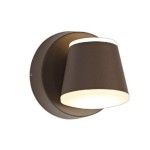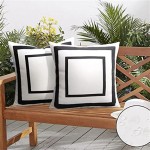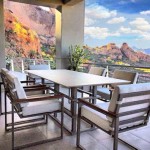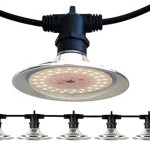Outdoor Rugs: Enhancing Your Dining Space
An outdoor dining area offers an opportunity to extend living spaces and enjoy meals in the open air. Enhancing this space with an outdoor rug provides both aesthetic appeal and functional benefits. When selecting an outdoor rug for a dining table, several factors need to be considered to ensure durability, suitability, and stylistic harmony. The right rug can transform a patio or deck into a cohesive and inviting dining environment.
The primary considerations when selecting an outdoor rug relate to its ability to withstand the elements. Unlike indoor rugs, outdoor rugs are exposed to sunlight, rain, humidity, and varying temperatures. Materials chosen for outdoor rugs must be inherently durable and resistant to fading, mildew, and moisture damage. Furthermore, the rug should be easy to clean and maintain, given its exposure to dirt, spills, and potential food debris. Size, style, and color are also important considerations, as these aspects contribute significantly to the overall aesthetic of the outdoor dining area.
Understanding Material Options for Outdoor Dining Rugs
The material composition of an outdoor rug is arguably the most critical factor influencing its performance and longevity. Several materials are commonly used in the manufacturing of outdoor rugs, each with its own set of advantages and disadvantages. Understanding these differences is essential for making an informed purchase.
Polypropylene: Polypropylene, also known as olefin, is a synthetic material widely used in outdoor rugs. It is highly resistant to moisture, stains, and fading, making it an excellent choice for outdoor use. Polypropylene rugs are also relatively inexpensive, offering a budget-friendly option for enhancing outdoor spaces. They are lightweight and easy to clean, typically requiring only a hose and mild detergent. However, polypropylene rugs can be susceptible to melting under high heat and may not have the same luxurious feel as some natural fiber rugs.
Polyester: Polyester is another synthetic material known for its durability and resistance to fading. It is often used in outdoor rugs as a more affordable alternative to polypropylene. Polyester rugs are generally soft underfoot and can mimic the look and feel of natural fibers. They are also resistant to mildew and mold, making them suitable for humid environments. Similar to polypropylene, polyester rugs are easy to clean and maintain. However, they may not be as resistant to stains as polypropylene and can be prone to shedding.
Nylon: Nylon is a highly durable synthetic fiber that is well-suited for high-traffic areas. Outdoor rugs made from nylon are resistant to abrasion, stains, and mildew. They are also relatively easy to clean and maintain. Nylon rugs tend to be more expensive than polypropylene or polyester rugs, but their superior durability can make them a worthwhile investment for those seeking a long-lasting outdoor rug. One potential drawback of nylon is its susceptibility to fading in direct sunlight, although newer nylon rugs often incorporate UV inhibitors to mitigate this issue.
Jute: Jute is a natural fiber derived from the jute plant. While jute rugs are often used indoors, they can also be used outdoors in covered areas. Jute rugs have a natural, textured look that can add warmth and character to an outdoor dining space. However, jute is highly absorbent and prone to mildew and mold in humid environments. Jute rugs are also more difficult to clean than synthetic rugs. Therefore, if considering a jute rug for outdoor use, it is essential to ensure that it is protected from rain and moisture.
Seagrass: Seagrass is another natural fiber option for outdoor rugs. Similar to jute, seagrass is best suited for covered outdoor areas. Seagrass rugs are durable and resistant to stains, but they are also susceptible to moisture damage. They have a natural, textured look and can add a coastal or bohemian vibe to an outdoor dining space. Seagrass rugs are relatively easy to clean, typically requiring only vacuuming and spot cleaning. However, they should be protected from excessive moisture to prevent mildew and mold growth.
Recycled Materials: In recent years, there has been a growing trend towards using recycled materials in outdoor rug manufacturing. These rugs are often made from recycled plastic bottles or other post-consumer waste. Recycled rugs offer an environmentally friendly option for outdoor decor. They are typically durable, resistant to moisture, and easy to clean. The appearance and texture of recycled rugs can vary depending on the specific materials used in their construction. Some recycled rugs closely resemble traditional synthetic rugs, while others have a more unique and textured look.
Choosing the Right Size and Shape for Your Dining Table Rug
Selecting the appropriate size and shape for an outdoor dining rug is crucial for creating a balanced and functional space. The rug should be large enough to accommodate all chairs when they are pulled out from the table, preventing them from snagging on the edge of the rug. The shape of the rug should complement the shape of the dining table and the overall layout of the outdoor dining area.
Size: As a general guideline, the rug should extend at least 24 to 36 inches beyond the edge of the dining table on all sides. This allows ample space for chairs to be pulled out without coming off the rug. For smaller dining tables, a rug that is 6 to 8 feet in diameter or length may be sufficient. For larger dining tables, a rug that is 9 to 12 feet in diameter or length may be necessary. Measuring the dining area and the dining table is essential to determine the ideal rug size. Consider the overall dimensions of the patio or deck and ensure that the rug does not overwhelm the space.
Shape: The shape of the rug should generally mirror the shape of the dining table. For a round dining table, a round rug is often the best choice. For a rectangular dining table, a rectangular rug is typically the most suitable option. However, there are exceptions to this rule. For example, a square rug can work well under a round dining table in a square or rectangular outdoor dining area. Similarly, an oval rug can complement a rectangular dining table in a space with curved lines or soft edges. Experimenting with different shapes can help to create a more visually interesting and dynamic outdoor dining space.
Beyond the shape of the table itself, also consider the shape of the overall dining area. If the space is long and narrow, a rectangular rug can help to visually elongate the area. If the space is square, a square or round rug can help to create a sense of balance and symmetry. Consider the placement of other outdoor furniture, such as lounge chairs or side tables, and ensure that the rug complements the overall layout of the space.
When determining the size and shape of the rug, it is important to consider practicality. A rug that is too large can make the space feel cramped and overwhelming. A rug that is too small can make the dining table feel disconnected and insignificant. It is also important to consider the potential for tripping hazards. Ensure that the edges of the rug are flat and secure, and that there are no loose fibers or frayed edges that could cause someone to stumble. Using a rug pad underneath the outdoor rug can help to prevent slipping and sliding and can also add extra cushioning.
Maintaining and Cleaning Your Outdoor Dining Rug
Proper maintenance and cleaning are essential for prolonging the life of an outdoor dining rug and keeping it looking its best. Regular cleaning can remove dirt, debris, and spills that can damage the rug and attract pests. The specific cleaning methods will depend on the material of the rug, but some general guidelines apply to all outdoor rugs.
Regular Vacuuming: Vacuuming the rug regularly, at least once a week, can help to remove loose dirt and debris before they become embedded in the fibers. Use a vacuum cleaner with a brush attachment to gently agitate the fibers and lift dirt. For rugs with a high pile, consider using a vacuum cleaner with adjustable height settings to prevent damage to the fibers.
Spot Cleaning: Promptly address spills and stains to prevent them from setting in. Blot the spill with a clean, absorbent cloth, working from the outside in to prevent spreading. Avoid rubbing the spill, as this can damage the fibers and make the stain more difficult to remove. For stubborn stains, use a mild detergent and water solution. Test the solution in an inconspicuous area of the rug first to ensure that it does not cause discoloration or damage. Apply the solution to the stain, gently blot with a clean cloth, and then rinse with water. Allow the rug to air dry completely before using it again.
Deep Cleaning: Periodically, the outdoor rug may require a more thorough cleaning. For synthetic rugs, such as polypropylene or polyester, hosing down the rug with water and mild detergent is often sufficient. Use a garden hose to spray the rug thoroughly, then scrub with a soft-bristled brush to remove dirt and stains. Rinse the rug with clean water and allow it to air dry completely. For natural fiber rugs, such as jute or seagrass, avoid excessive moisture. Instead, vacuum the rug thoroughly and spot clean as needed. Consider having natural fiber rugs professionally cleaned to prevent damage.
Preventative Measures: Taking preventative measures can help to minimize the need for frequent cleaning. Use doormats at entrances to prevent dirt and debris from being tracked onto the rug. Place furniture protectors under the legs of chairs and tables to prevent damage to the rug fibers. Avoid placing the rug in direct sunlight, as this can cause fading. If the rug is exposed to rain, allow it to air dry completely to prevent mildew and mold growth. Consider rotating the rug periodically to distribute wear evenly.
By selecting an outdoor rug that is appropriate for the dining area, and by implementing a regular cleaning and maintenance routine, you can ensure that your outdoor dining space remains beautiful and inviting for years to come. The careful consideration of materials, size, shape, and maintenance practices will contribute significantly to the overall enjoyment and longevity of the outdoor rug.

How To Decorate Your Patio Area With A Rug Sunniland Furniture In Boca Raton

Outdoor Rugs Guide How To Choose The Perfect Size For Your Space

Hot Take You Should Definitely Get An Indoor Outdoor Rug For Your Dining Room

Rug Under Outdoor Dining Table Design Ideas

Banstead Outdoor Carpet Clearance

Innaloo 3d Outdoor Area Rug

Buy Lhasa Orange Violet Recycled Plastic Outdoor Rug Online

Allen Roth New Haven Outdoor Rug Polypropylene 5 Ft X 7 Brown And Black 30901890 5x7r Rona

Dining Delight Room Annie Selke

Tan And Gray Striped Outdoor Rug Design Ideas








